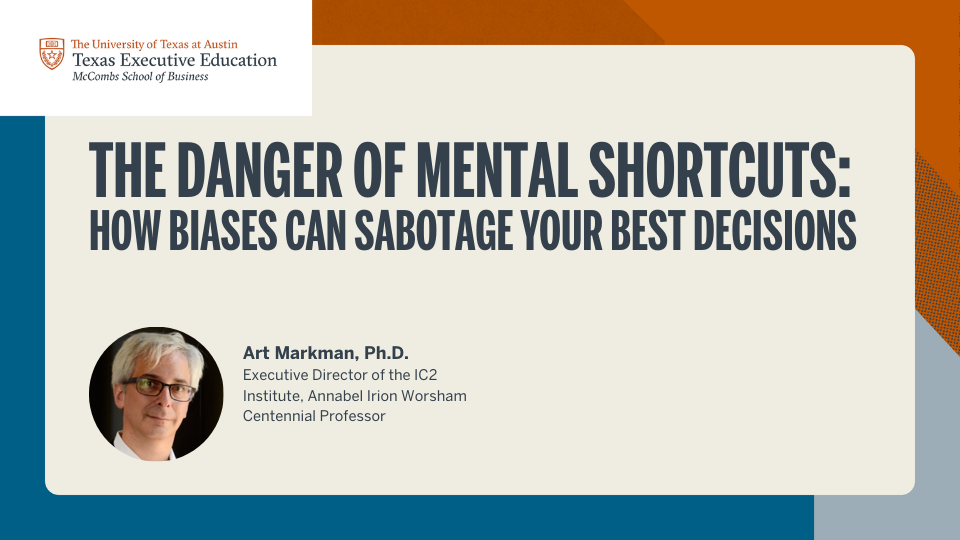We make hundreds of decisions every day—what we think are reasonable, logical, smart decisions. That’s because we assume what we already know is all we need to know to make those choices. Unfortunately, there’s something else at play: our biases. These biases lead us to missing or overlooking the potential facts and figures that could alter our decisions, and in turn, lead us to even better decisions in the end.
Although implicit biases are not something we often think about, they do shape every decision we make. Gain perspective on your own decision-making by being aware of the 3 types of biases: availability, confirmation, and conformity. These could be clouding your judgement, but there are ways to prevent their impacts in your workplace decision-making.

First Things First: Availability Bias
Availability bias happens when you use readily available information that is more representative to you than may be true, to make decisions and assumptions about the world. When you are confronted with making a decision your brain takes the path of least resistance, and that’s usually the information that comes to mind first. You may hear about a colleague getting assigned to a project in a new industry. With availability bias present, you might think there’s an increased chance that will happen for you, and impact the decisions you make about your own projects because of this assumed potential.
If you rely on this, you’ll be making rushed decisions that are not well thought-out or thorough. The dangers are that you assume you have all the information (which you probably do not), and these easily-accessible facts and figures become your crutch.
So, how do you break free from this bias in the workplace?
- Give second thought to top of mind information. Set high standards for your thought process, making sure you allot time and effort to gathering evidence to shape your opinions.
- Form a diverse team that has a variety of experiences and viewpoints. The natural tendency to challenge each others’ ideas will help to limit availability bias.
- Absorb as much information as you can. Continuously learning and practicing, and taking a step back to consult multiple sources, will make sure you don’t depend on the comfort of availability bias.
What You Believe Is What You See: Confirmation Bias
Confirmation bias is the tendency to seek out and interpret new information that confirms your current beliefs. The danger is this information confirms what you already think is true, even if it’s not. This cherry-picking of ideas and opinions can lead to a skewed sense of reality.
Confirmation bias means you run the risk of only seeing parts of the bigger picture that confirm your current assumptions. Confirmation bias relies on preconceived notions, and those can be wrong. If we need to make decisions quickly, this bias is an easy way to do so, but that doesn’t make it the best - or even correct - way.
So, how do you eliminate this bias in your decision-making?
- Remove all the facts you think you know, and start with a neutral fact base. Research and gather information from a range of sources. Choose sources outside those you normally reference to gain insight into sides of the story you wouldn’t have otherwise considered.
- Diversify who you listen to, articles you read, and people you follow. Let’s say you work in the public sector. Although you might think it’s not applicable, consider reading business pieces about the private sector and the inner workings of companies different from yours. Your initial belief would be this is not relatable, but the applicable takeaways you can learn will surprise you.
- Put your decisions in context. Being open to seeing other perspectives and trying to understand the ‘why’ behind multiple angles will expand your knowledge.
Fit the Mold: Conformity Bias
Conformity bias is making decisions based on the majority’s opinion. If you notice others behaving in a certain way, you may assume that it’s appropriate. Conformity bias says you would follow suit and behave in the same manner.
In the workplace you are impacted by those around you, especially when you surround yourself with like-minded individuals. Conformity bias thwarts individuals from sharing and expressing their unique opinions because of fear of retaliation, punishment, or excommunication from the group at large. Simply put, it’s easier to agree with the majority opinion than to voice objections or concerns.
So, how do you escape conformity bias?
- Create an inclusive and open culture that encourages vulnerability. Your team members are not going to feel confident sharing their viewpoints if the environment is toxic or unwelcoming.
- Play the devil’s advocate. If everyone is giving the impression that they’re in agreement about an idea or opinion but you’re aware it’s not the unanimous feeling, you can bring up the opposing ideas. Stir the pot—healthy debate is a good thing.
Conformity bias can be hard to combat, and there are other ways you can address conformity bias. For a more in-depth look at how to not fall prey to this type of bias, read more in this playbook.
Steer Clear of These Biases
Breaking free of our biases takes time and conscious effort. Knowing you are influenced by what you think you know is the first step. These three biases can have a profound impact on the quality of your decisions, and you might even come to the wrong conclusions because of them. While sometimes it’s unintentional, you and your team can make the conscious effort to remove these biases from your workplace. By consulting diverse viewpoints, not rushing into premature conclusions, and creating environments where your team feels comfortable and confident in sharing their own unique opinions you can help to encourage better decision making. Awareness of these biases is the first step, and it’s well worth taking the journey to make better, higher quality decisions.
Interested in learning more about how the mind works and how behavioral thinking leads to biases? We have a course for that—Human Biases in Decision Making: Avoiding the Traps












